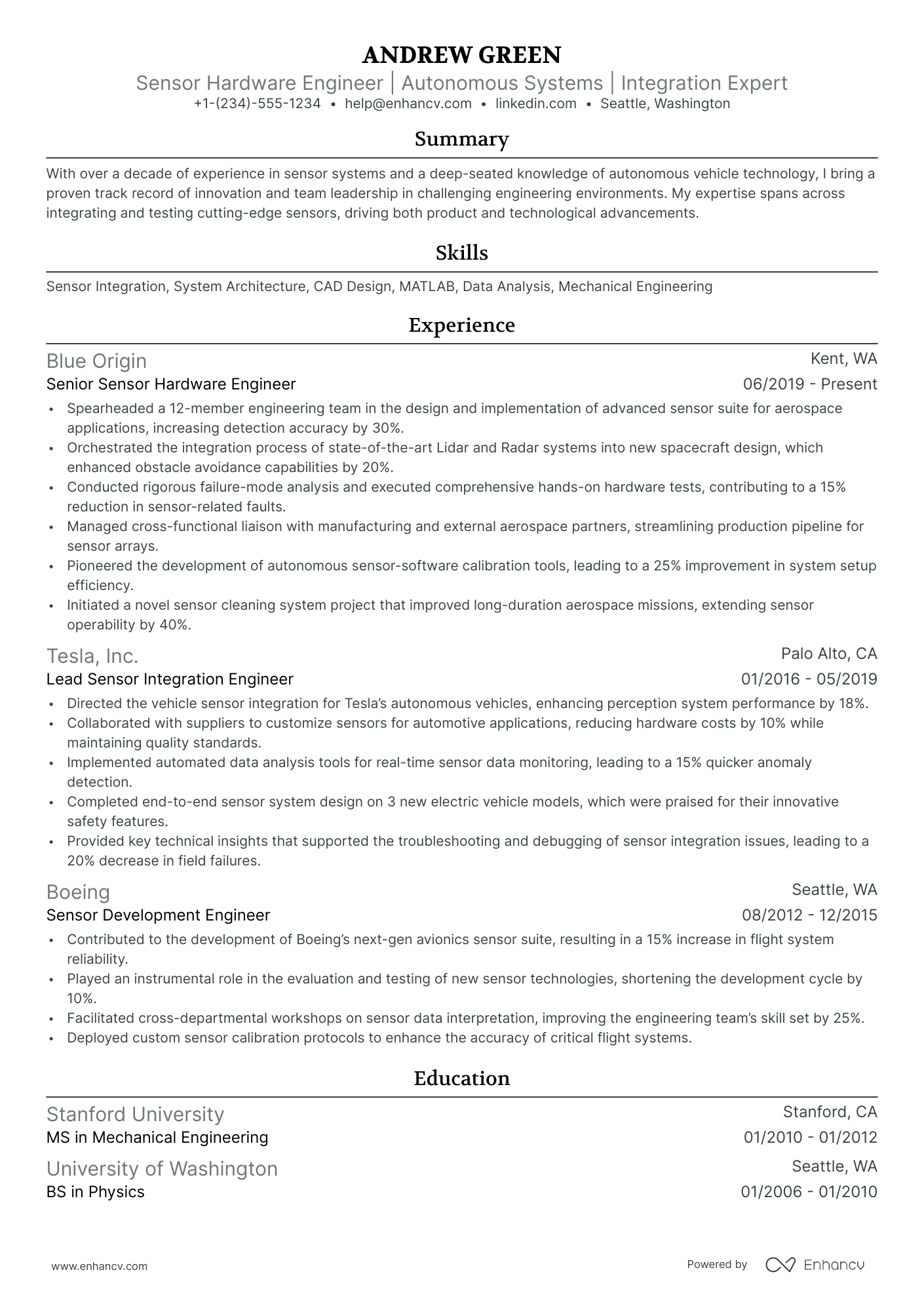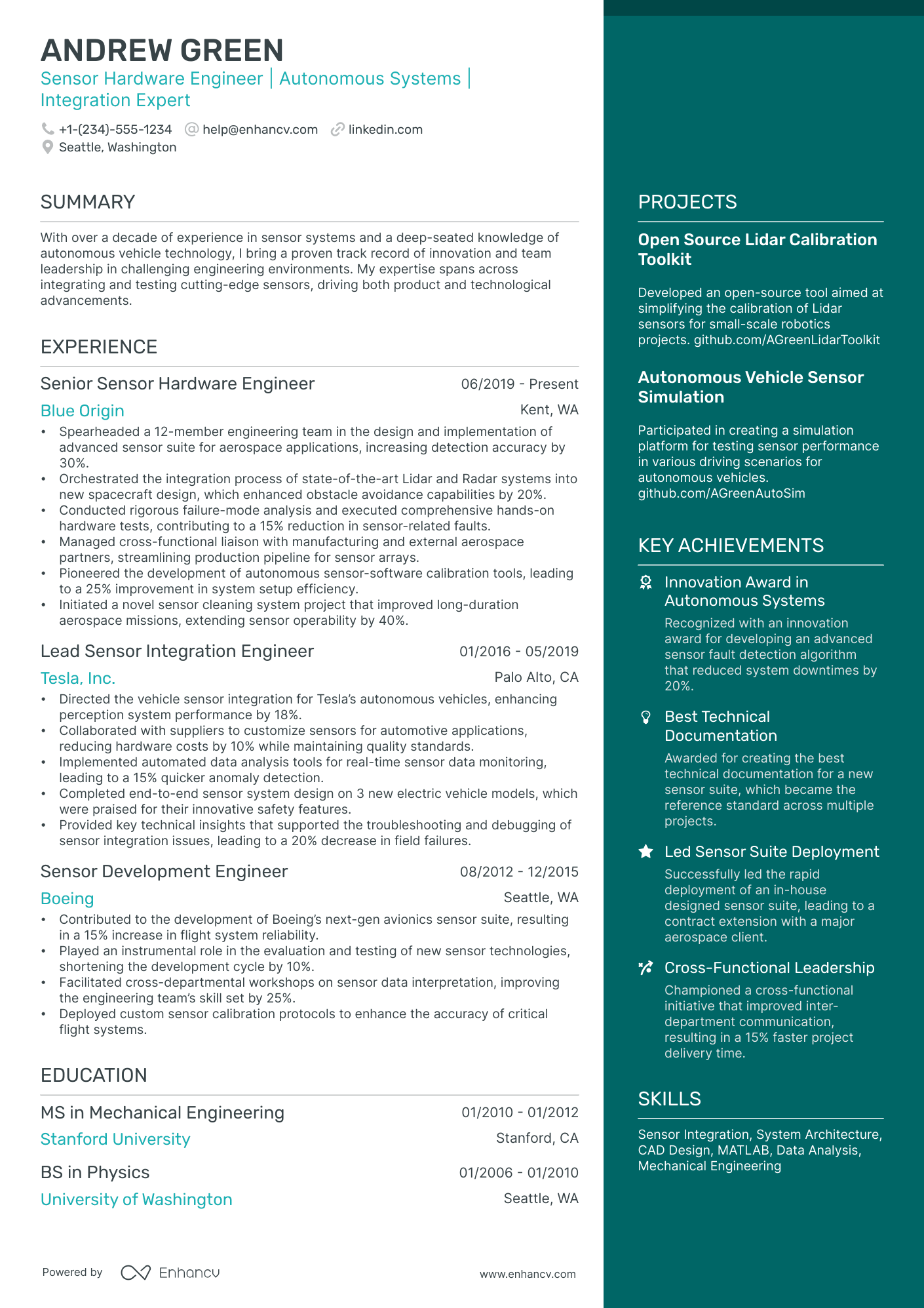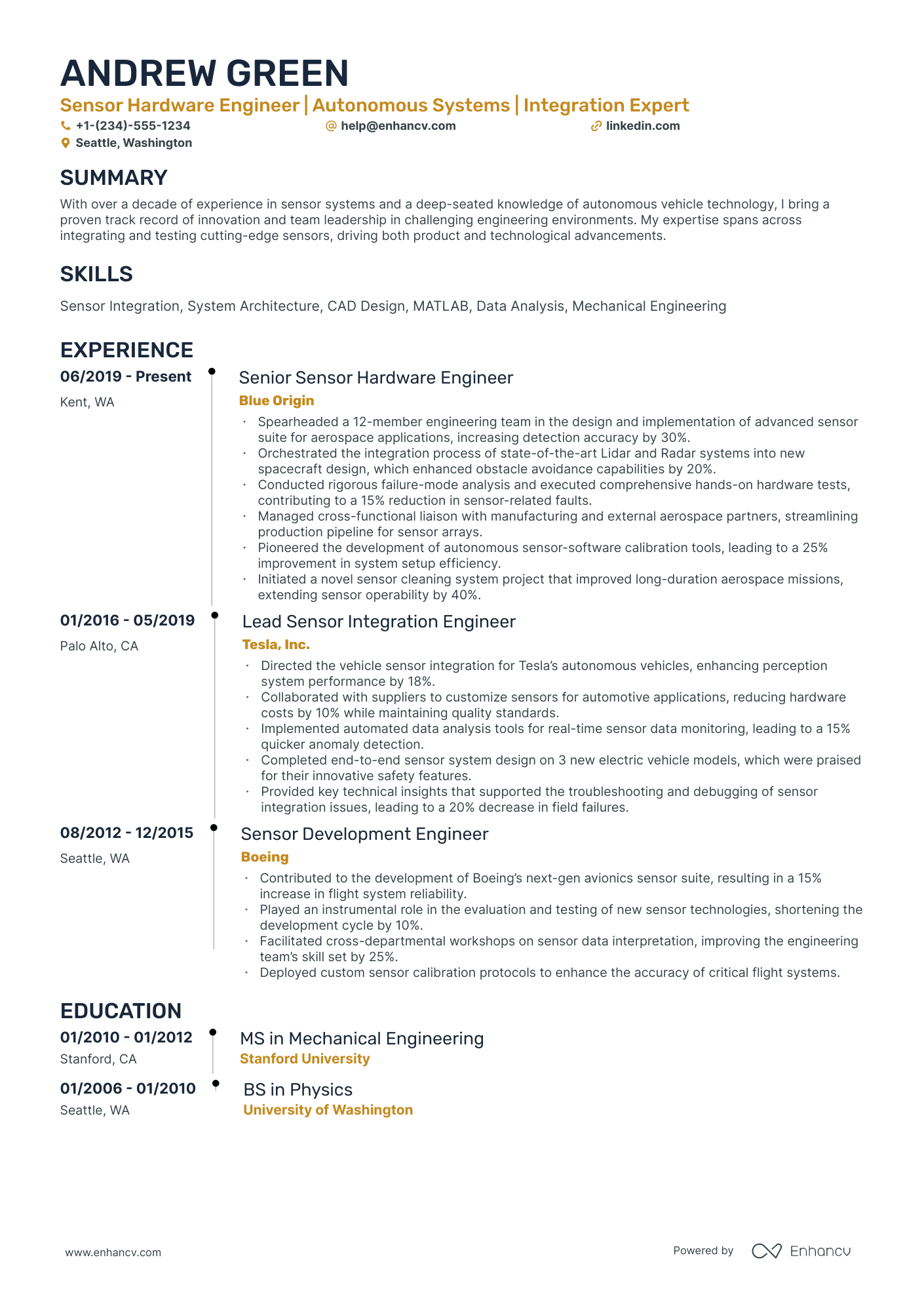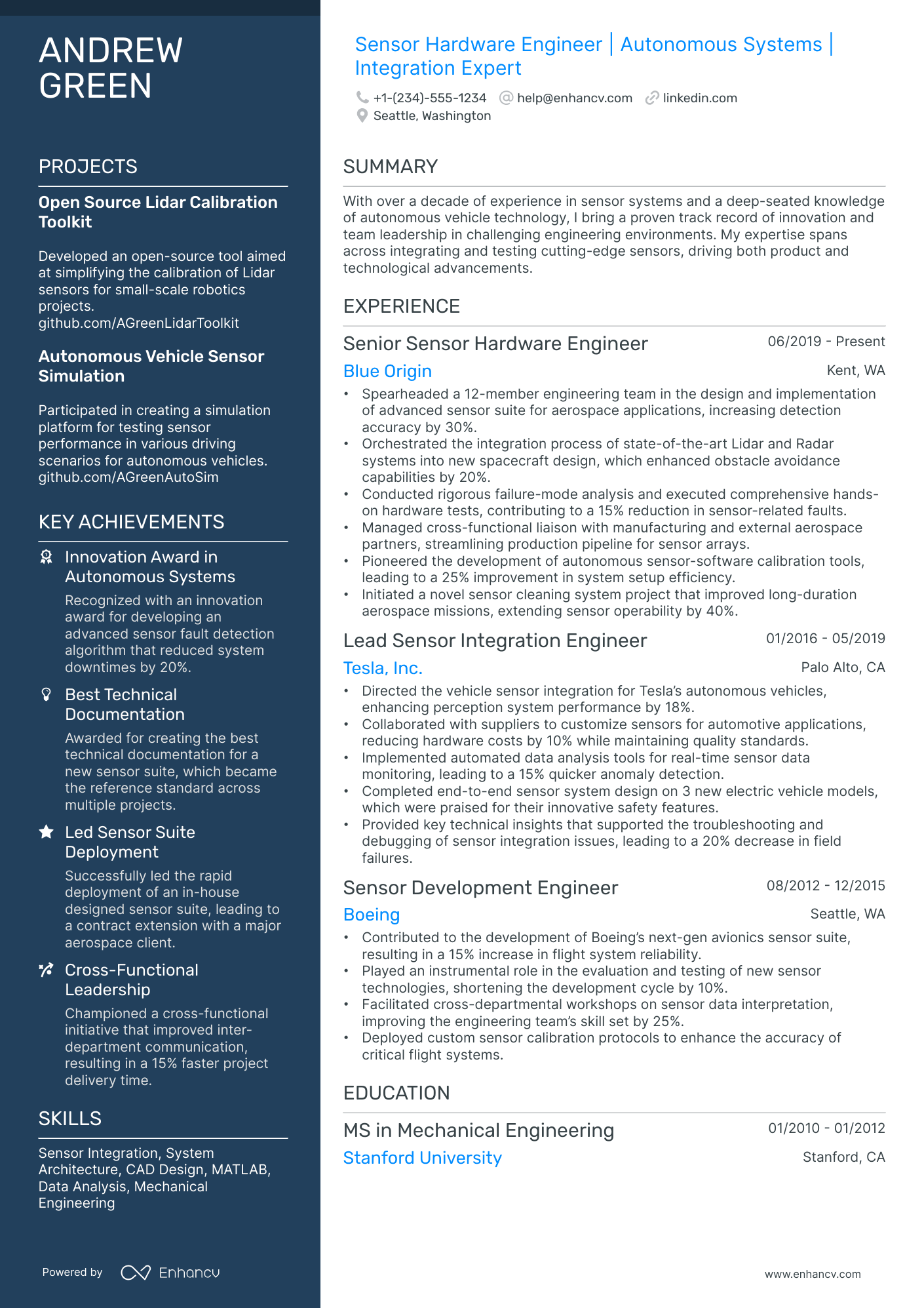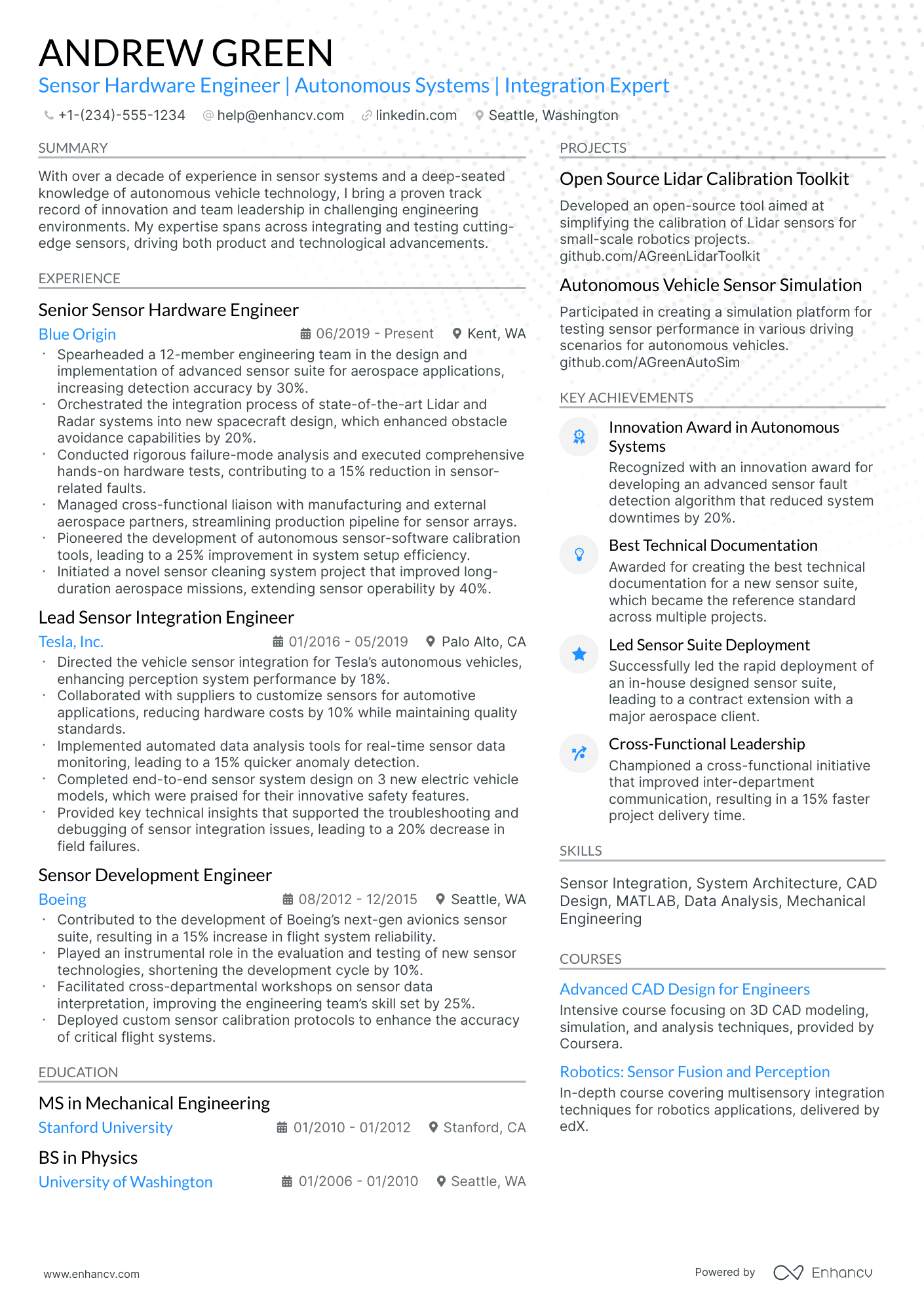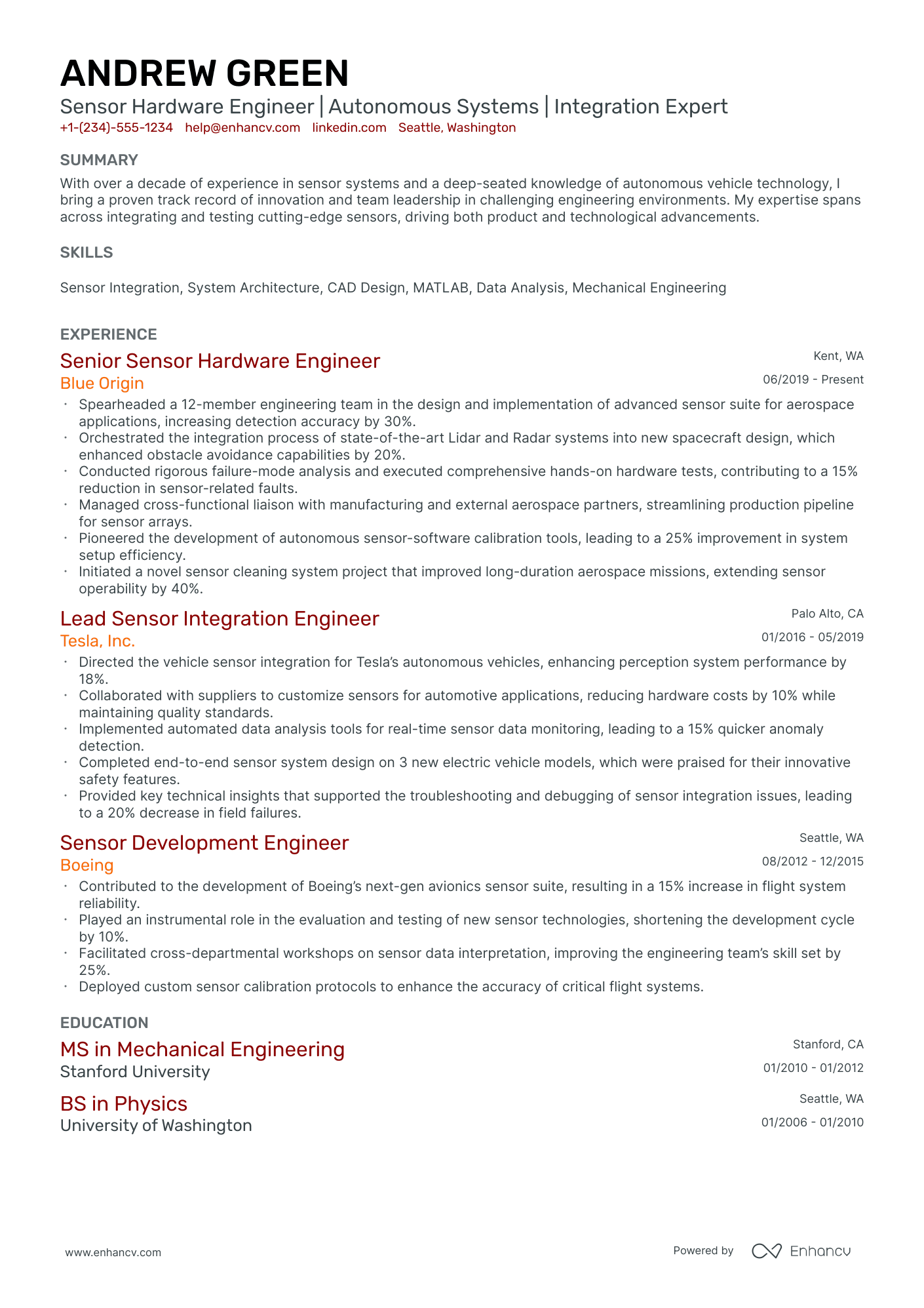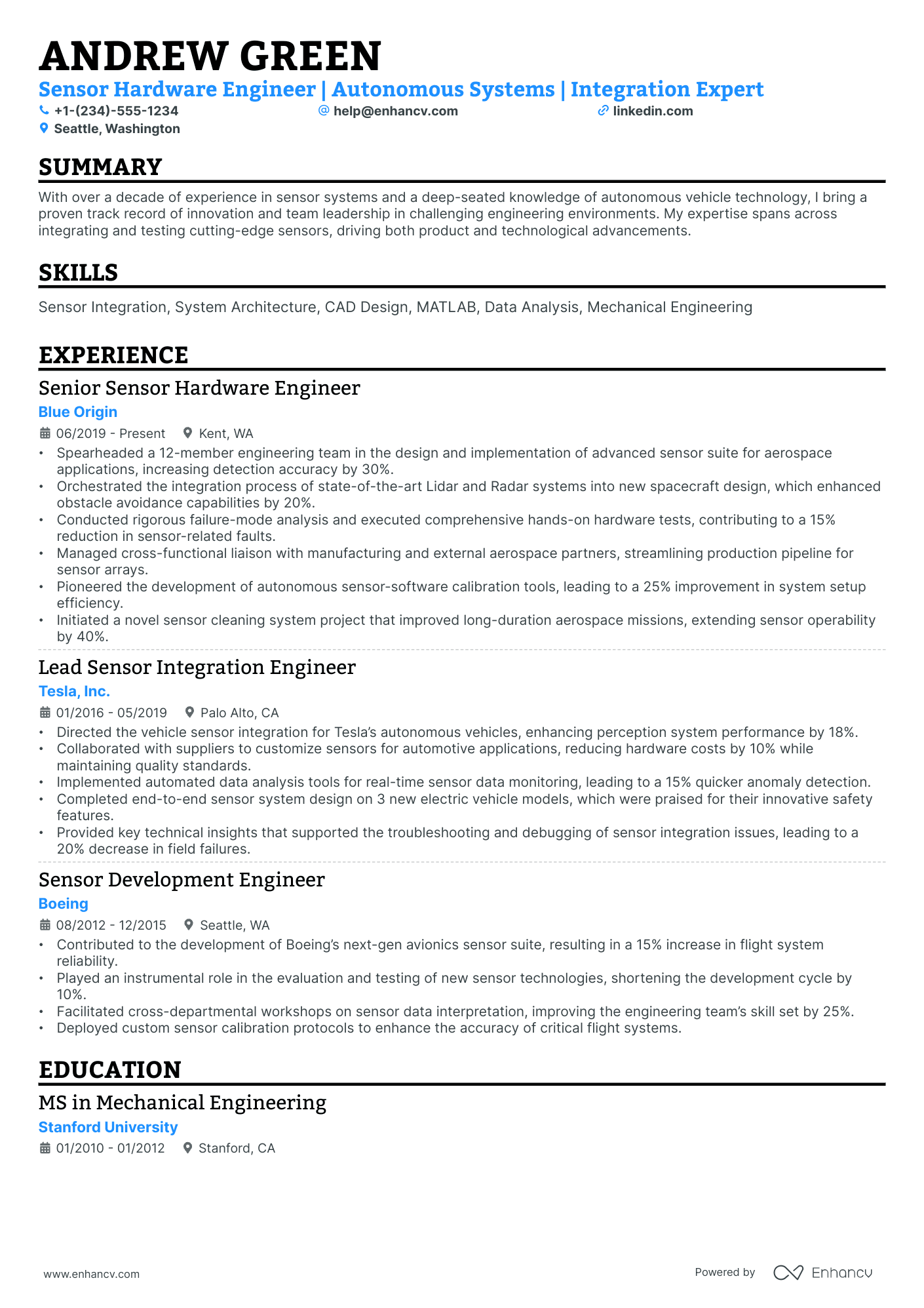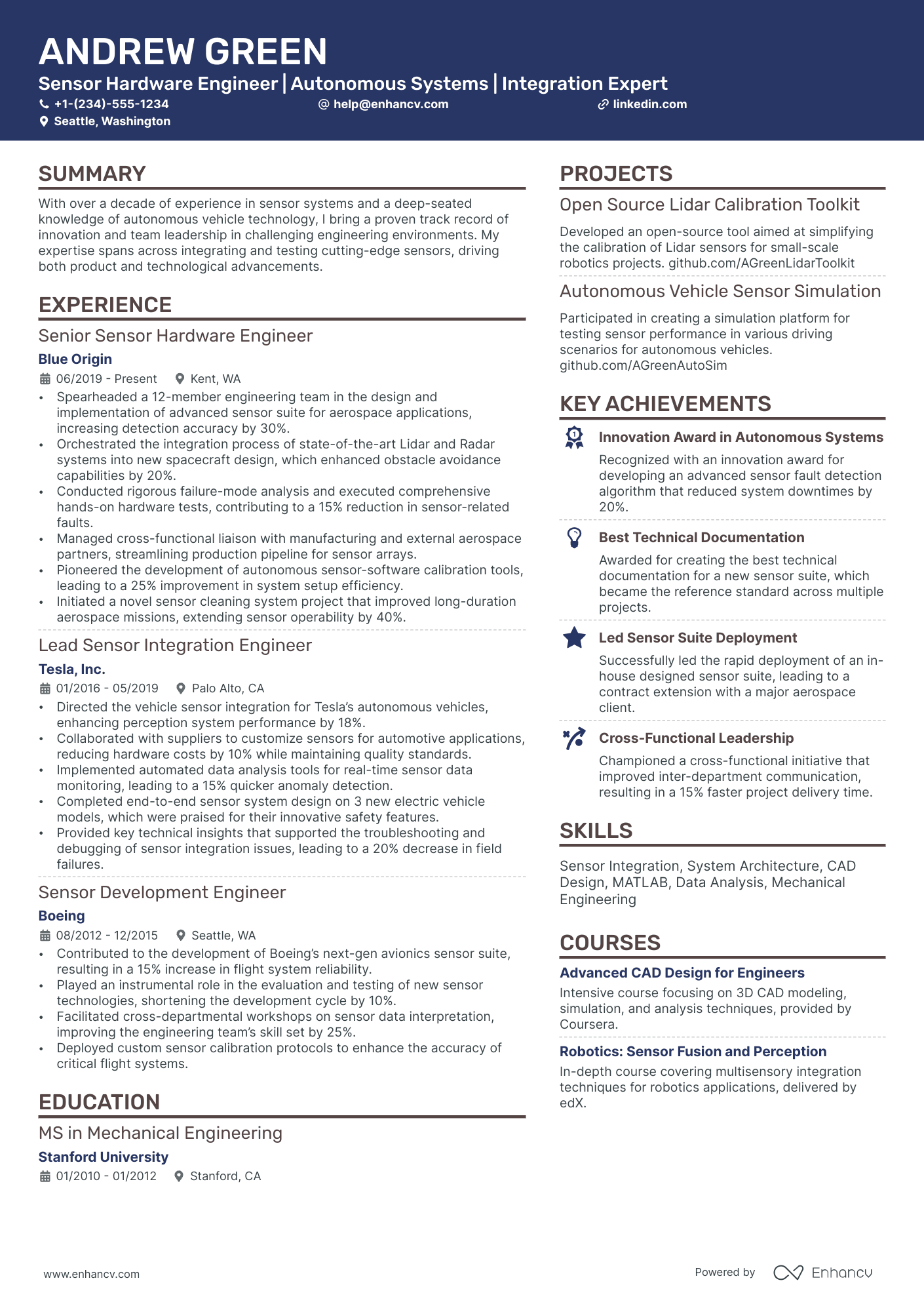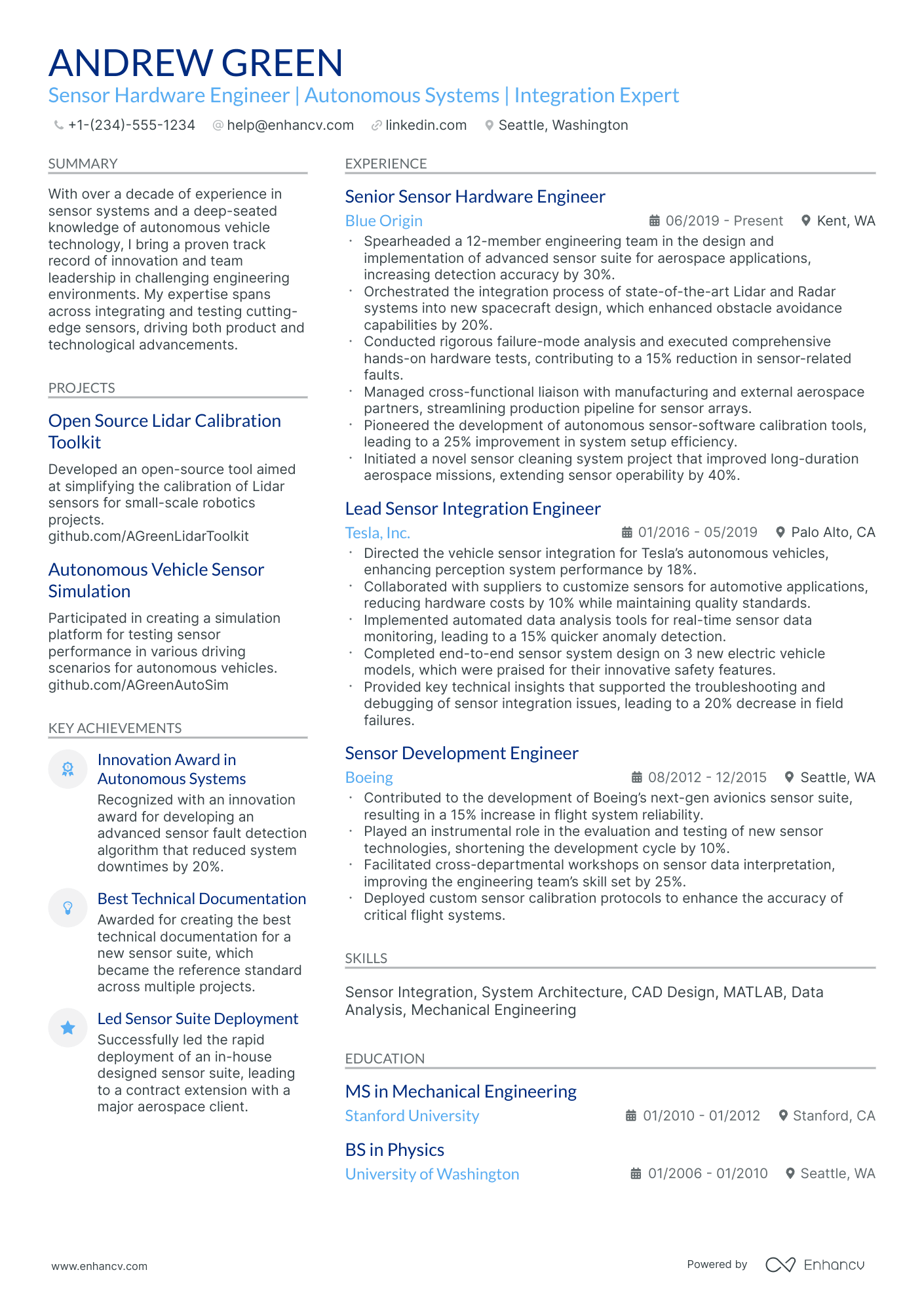As a hardware engineer, you may struggle with effectively showcasing your complex projects and technical skills within the concise format of a resume. Our guide provides strategies to distill your technical accomplishments into impactful, easy-to-understand bullets, ensuring you stand out to hiring managers.
- Apply best practices from professional resumes to spotlight your application;
- Quantify your professional experience with achievements, career highlights, projects, and more;
- Write an eye-catching hardware engineer resume top one-third with your header, summary/objective, and skills section;
- Fill in the gaps of your experience with extracurricular, education, and more vital resume sections.
We've selected, especially for you, some of our most relevant hardware engineer resume guides. Getting you from thinking about your next career move to landing your dream job.
- Service Desk Manager Resume Example
- Sophomore Engineering Resume Example
- Web Project Manager Resume Example
- IT Specialist Resume Example
- IT Service Manager Resume Example
- IT Operations Manager Resume Example
- Game Developer Resume Example
- L2 Network Engineer Resume Example
- Cmm Programmer Resume Example
- PLC Programmer Resume Example
The importance of format and layout in your hardware engineer resume
Consider you're an HR professional at company X, evaluating two hardware engineer candidate resumes. John Smith presents a simple, traditional, and easy-to-read resume. Edward Price, however, uses a non-conventional, often illegible format. Whose resume would you spend more time on to understand their experience? This scenario underscores the importance of your hardware engineer resume’s design. It should be simply formatted and clearly communicate why you are the ideal candidate for the role.Achieve this balance by:
- Listing your experience, beginning with the most recent and relevant, in reverse chronological order;
- Ensuring your header contains essential information, such as contact details, a headline, and a portfolio link. Include a professional photo in the hardware engineer resume header if you have one;
- Including only the most important and relevant resume sections to showcase your expertise and stand out from other candidates;
- Editing your hardware engineer resume to be no longer than two pages if you have extensive relevant experience. Use your limited resume space judiciously.
Also, remember that your hardware engineer resume might initially be scanned by an Applicant Tracker System (ATS).
When it comes to ATS:
- Opt for simple and legible fonts like Raleway, Rubik, Lato, etc., making your experience easy for the ATS to scan;
- Use serif and sans-serif fonts, both of which are ATS-friendly;
- Avoid overused options like Arial and Times New Roman, which, while suitable, may lack personality.
Contrary to a common myth, our recent study shows that the ATS can effectively process both one-column and two-column resumes. Learn more about this in the ATS myths guide.
Finally, when submitting your hardware engineer resume, always export it as a PDF to ensure all information remains intact, making the document easier to print, read, and scan.
Upload & Check Your Resume
Drop your resume here or choose a file. PDF & DOCX only. Max 2MB file size.
PRO TIP
The more time and effort you've put into obtaining the relevant certificate, the closer to the top it should be listed. This is especially important for more senior roles and if the company you're applying for is more forward-facing.
Traditional sections, appreciated by recruiters, for your hardware engineer resume:
- Clear and concise header with relevant links and contact details
- Summary or objective with precise snapshot of our career highlights and why you're a suitable candidate for the hardware engineer role
- Experience that goes into the nuts and bolts of your professional qualifications and success
- Skills section(-s) for more in-depth talent-alignment between job keywords and your own profile
- Education and certifications sections to further show your commitment for growth in the specific niche
What recruiters want to see on your resume:
- Experience with specific hardware design tools, such as CAD software (e.g., Altium, Eagle, OrCAD).
- Knowledge of hardware testing methodologies and experience with test equipment such as oscilloscopes, multimeters, and logic analyzers.
- Understanding of different communication protocols (e.g., I2C, SPI, UART, USB) and experience designing hardware that uses them.
- Demonstrated ability to work with cross-functional teams, including software engineers, to develop integrated systems.
- Expertise in PCB layout, schematics, and component selection for reliability and manufacturability.
The hardware engineer resume experience section: a roadmap to your expertise
The resume experience section provides you with an opportunity to tell your professional narrative.
Recruiters, reading between the lines of your resume, use the experience section to better understand your unique skill set, accomplishments, and what unique value you bring about.
Discover five quick steps on how to write your experience section:
- Curate only relevant experience items to the role and include the company, description, and dates; all followed by up to six bullets per experience item;
- Each experience item should feature tangible results of your actions - if you can include a number or percent, this will further highlight your aptitude;
- If you've received any managerial or customer feedback, use short excerpts of it as further social proof of your technical or people skills;
- Make sure you're using the appropriate verb tense when listing your responsibilities;
- Within the description for each role, you could summarize your most noteworthy and relevant achievements.
Now, take note of how a real-world hardware engineer professional received opportunities at industry leaders with these resume experience sections:
- Led the cross-functional team for the development of a high-performance computing platform, improving processing speeds by 20% over previous models.
- Managed the complete lifecycle of hardware development projects, from concept to production, ensuring adherence to cost, schedule, and performance targets.
- Streamlined testing procedures for new hardware systems, resulting in a 15% reduction in time-to-market for products without compromising quality.
- Conceptualized and executed innovative motherboard designs that increased system stability by 35%, positively impacting customer satisfaction.
- Coordinated with global suppliers to source high-quality components, reducing material costs by 25% while maintaining product standards.
- Pioneered the use of energy-efficient power supply units in consumer-grade hardware, cutting power consumption by up to 30% for end-users.
- Conducted exhaustive component stress testing, enhancing device reliability and extending average product lifetime by 2 years.
- Introduced automated test scripts that augmented quality assurance efficiency by 40%, scaling production capabilities without additional headcount.
- Collaborated directly with software teams to optimize hardware for new operating systems, which decreased boot-up times by 50%.
- Implemented a state-of-the-art network hardware deployment, enhancing company data center bandwidth capabilities by over 100 Gbps.
- Established key performance benchmarks for new server hardware that became company standards, ensuring a consistent level of service.
- Authored comprehensive hardware documentation that facilitated a 20% faster onboarding process for the engineering team.
- Spearheaded the migration to advanced semiconductor materials, achieving a 30% decrease in energy consumption for our microprocessors.
- Orchestrated collaborative efforts with the software division to tailor hardware architectures to specific applications, enhancing system performance by 25%.
- Mentored a team of junior hardware engineers, fostering a culture of innovation and continuous improvement.
- Redesigned the signal processing pipeline for mobile devices, which enhanced audio quality and increased market share by 10%.
- Deployed robust security features in hardware design that met international encryption standards, enabling entry into new government and defense markets.
- Provided critical support in patenting new hardware technologies, resulting in the granting of 5 patents that solidified the company's intellectual property portfolio.
- Optimized FPGA designs for signal processing applications, which reduced latency by 40% for high-frequency trading platforms.
- Engineered hardware solutions that successfully met the stringent requirements of automotive industry standards, like ISO 26262, advancing the company's automotive market presence.
- Facilitated the transition to a modular hardware design philosophy, cutting down on development time by 30% and allowing for agile responses to market changes.
- Developed an innovative thermal management system for data center hardware that increased cooling efficiency by 20%, resulting in lower operational costs.
- Played a pivotal role in the design of next-generation storage hardware that doubled data transfer rates compared to previous models.
- Crafted detailed specifications for custom hardware components, leading to enhanced compatibility with third-party vendors and broadening the hardware ecosystem.
The following content includes information from "O*NET OnLine" by the U.S. Department of Labor, Employment and Training Administration (USDOL/ETA). Used under the CC BY 4.0 license. The data represents the top responsibilities present on the task lists for hardware engineer professionals.
Top Responsibilities for Hardware Engineer:
- Update knowledge and skills to keep up with rapid advancements in computer technology.
- Design and develop computer hardware and support peripherals, including central processing units (CPUs), support logic, microprocessors, custom integrated circuits, and printers and disk drives.
- Confer with engineering staff and consult specifications to evaluate interface between hardware and software and operational and performance requirements of overall system.
- Build, test, and modify product prototypes, using working models or theoretical models constructed with computer simulation.
- Write detailed functional specifications that document the hardware development process and support hardware introduction.
- Test and verify hardware and support peripherals to ensure that they meet specifications and requirements, by recording and analyzing test data.
- Direct technicians, engineering designers or other technical support personnel as needed.
- Provide technical support to designers, marketing and sales departments, suppliers, engineers and other team members throughout the product development and implementation process.
- Select hardware and material, assuring compliance with specifications and product requirements.
- Store, retrieve, and manipulate data for analysis of system capabilities and requirements.
Quantifying impact on your resume
- Include the number of successful hardware projects completed, demonstrating experience and productivity.
- List financial figures showcasing money saved through cost-effective hardware solutions, reflecting a sense of fiscal responsibility.
- Quantify any improvements in system performance metrics, such as increased processing speed or efficiency, to demonstrate technical impact.
- Specify the scale of the infrastructure you have worked on, such as the number of servers or endpoints, which highlights the scope of your expertise.
- Detail the percentages by which you improved hardware reliability and reduced downtime, showing a commitment to quality and continuity.
- Include numbers related to reductions in hardware failures or mean time between failures that your work achieved, proving a focus on product longevity.
- Mention the number of cross-functional teams you have collaborated with, pointing to strong interpersonal and collaboration skills.
- Report the size of inventories or the number of components managed, giving a sense of your organizational and planning abilities.
Action verbs for your hardware engineer resume
Making the most of your little to none professional experience
If you're hesitant to apply for your dream job due to limited professional experience, remember that recruiters also value the unique contributions you can offer.
Next time you doubt applying, consider this step-by-step approach for your resume's experience section:
- Rather than the standard reverse chronological order, opt for a functional-based format. This shifts the focus from your work history to your achievements and strengths;
- Include relevant internships, volunteer work, or other non-standard experiences in your hardware engineer resume's experience section;
- Utilize your education, qualifications, and certifications to bridge gaps in your hardware engineer resume experience;
- Emphasize your interpersonal skills and transferable skills from various industries. Often, recruiters seek a personality match, giving you an advantage over other candidates.
Recommended reads:
PRO TIP
Always remember that your hardware engineer certifications can be quantified across different resume sections, like your experience, summary, or objective. For example, you could include concise details within the expertise bullets of how the specific certificate has improved your on-the-job performance.
Hardware engineer skills and achievements section: must-have hard and soft skills
A key principle for your hardware engineer resume is to prominently feature your hard skills, or the technologies you excel in, within the skills section. Aim to list several hard skills that are in line with the job's requirements.
When it comes to soft skills, like interpersonal communication abilities and talents, they're trickier to quantify.
Claiming to be a good communicator is one thing, but how can you substantiate this claim?
Consider creating a dedicated "Strengths" or "Achievements" section. Here, you can describe how specific soft skills (such as leadership, negotiation, problem-solving) have led to concrete achievements.
Your hardware engineer resume should reflect a balanced combination of both hard and soft skills, just as job requirements often do.
Top skills for your hardware engineer resume:
Circuit Design
PCB Layout
FPGA Development
Embedded Systems Programming
Signal Processing
Hardware Debugging
Analog and Digital Electronics
Microcontroller Programming
CAD Software (e.g., Altium, Eagle)
Testing and Validation
Problem Solving
Team Collaboration
Attention to Detail
Communication Skills
Time Management
Adaptability
Critical Thinking
Creativity
Project Management
Analytical Skills
Next, you will find information on the top technologies for hardware engineer professonals from "O*NET OnLine" by the U.S. Department of Labor, Employment and Training Administration (USDOL/ETA). Used under the CC BY 4.0 license.
Top technologies for Hardware Engineer’s resume:
- SAS
- The MathWorks MATLAB
- Eko
- Autodesk AutoCAD
- Dassault Systemes CATIA
PRO TIP
If the certificate you've obtained is especially vital for the industry or company, include it as part of your name within the resume headline.
Hardware engineer-specific certifications and education for your resume
Place emphasis on your resume education section . It can suggest a plethora of skills and experiences that are apt for the role.
- Feature only higher-level qualifications, with details about the institution and tenure.
- If your degree is in progress, state your projected graduation date.
- Think about excluding degrees that don't fit the job's context.
- Elaborate on your education if it accentuates your accomplishments in a research-driven setting.
On the other hand, showcasing your unique and applicable industry know-how can be a literal walk in the park, even if you don't have a lot of work experience.
Include your accreditation in the certification and education sections as so:
- Important industry certificates should be listed towards the top of your resume in a separate section
- If your accreditation is really noteworthy, you could include it in the top one-third of your resume following your name or in the header, summary, or objective
- Potentially include details about your certificates or degrees (within the description) to show further alignment to the role with the skills you've attained
- The more recent your professional certificate is, the more prominence it should have within your certification sections. This shows recruiters you have recent knowledge and expertise
At the end of the day, both the education and certification sections hint at the initial and continuous progress you've made in the field.
And, honestly - that's important for any company.
Below, discover some of the most recent and popular hardware engineer certificates to make your resume even more prominent in the applicant pool:
The top 5 certifications for your hardware engineer resume:
- Certified Electronics Technician (CET) - International Society of Certified Electronics Technicians (ISCET)
- Certified Interconnect Designer (CID) - Association Connecting Electronics Industries (IPC)
- Certified Interconnect Designer-Advanced (CID+) - Association Connecting Electronics Industries (IPC)
- Project Management Professional (PMP) - Project Management Institute (PMI)
- Lean Six Sigma Certification - American Society for Quality (ASQ)
The content below includes information from "O*NET OnLine" by the U.S. Department of Labor, Employment and Training Administration (USDOL/ETA). Used under the CC BY 4.0 license. The data represents the top associations for hardware engineer professionals.
Top US associations for a Hardware Engineer professional
- Accreditation Board for Engineering and Technology
- American Society for Engineering Education
- Association for Computing Machinery
- CompTIA
- IEEE Computer Society
PRO TIP
If the certificate you've obtained is especially vital for the industry or company, include it as part of your name within the resume headline.
Recommended reads:
The hardware engineer resume summary or objective: integrating keywords, achievements, and more
Deciding whether to include a resume summary or an objective in your hardware engineer resume is crucial. Both serve as key introductory elements at the top of your resume, encapsulating your profile in up to five sentences and incorporating relevant keywords from the job advert.
Here are the key differences between the two:
- The resume summary focuses on aligning your achievements and experience with the job requirements. It provides recruiters with a snapshot of your expertise, helping you stand out as an ideal candidate for the role.
- The resume objective, on the other hand, centers on your career goals and aspirations, detailing how the role aligns with your career progression. It's particularly suitable for candidates with less professional experience or those new to the job market.
Below are examples demonstrating best practices in utilizing the resume summary and/or objective to make a strong first impression with your hardware engineer resume.
Resume summaries for a hardware engineer job
- Seasoned hardware engineer with over 12 years of experience in FPGA design and electromechanical systems optimization for multinational tech firms seeks to leverage deep expertise in embedded system development and a track record of reducing manufacturing costs by 15% through innovative design solutions.
- Software developer with a decade of experience in Java and Python pivoting to hardware engineering, eager to apply strong analytical skills and a passion for efficient computing architectures to develop cutting-edge hardware solutions, bringing a fresh perspective from software optimization techniques.
- With 15 years of professional engineering in automotive industries, now transitioning to hardware engineering with a strong foundation in thermodynamics and material science, aiming to contribute to advanced computing hardware initiatives with proven problem-solving abilities and design acumen.
- Dedicated and results-driven individual with a recent degree in electrical engineering, excited to embark on a hardware engineering path by bringing fresh knowledge of modern circuitry and enthusiasm for tech advancements with a deep commitment to learning industry best practices.
- Recent graduate in mechanical engineering with internships at major aerospace firms, ready to transfer my analytical skills, solid understanding of dynamics, and eagerness to contribute to the technological evolution in a hardware engineering capacity focused on creating groundbreaking gadgets.
- Aspiring hardware engineer with a passion for technology and sustainable design, seeks to apply strong foundation in physics and computer science from an academic background to practical engineering problems, determined to craft energy-efficient and high-performance hardware solutions while developing professional expertise.
Average salary info by state in the US for Hardware Engineer professionals
Local salary info for Hardware Engineer.” Source: My Next Move, National Center for O*NET Development. Accessed 10/15/2024
| State | Average Salary (in USD) |
|---|---|
| US National Average | $138,080 |
| California (CA) | $169,700 |
| Texas (TX) | $124,630 |
| Florida (FL) | $113,280 |
| New York (NY) | $136,170 |
| Pennsylvania (PA) | $116,140 |
| Illinois (IL) | $123,590 |
| Ohio (OH) | $99,100 |
| Georgia (GA) | $106,460 |
| North Carolina (NC) | $131,010 |
| Michigan (MI) | $115,610 |
Other hardware engineer resume sections to support your expertise and skills
Recruiters are always on the lookout for that hardware engineer candidate who brings about even more value to the role.
This can be either via their personality or additional accreditations they have across the industry.
Add to your resume any of the four sections that fit your profile:
- Projects for your most impressive, cutting-edge work;
- Awards or recognitions that matter the most;
- Publications further building up your professional portfolio and accreditations;
- Hobbies and interests to feature the literature you read, how you spend your time outside of work, and other personality traits you deem may help you stand out .
Key takeaways
- Your hardware engineer resume is formatted professionally and creates an easy-to-read (and -understand) experience for recruiters;
- You have included all pertinent sections (header, summary/objective, experience, skills, certifications) within your hardware engineer resume;
- Instead of just listing your responsibilities, you've qualified them with skills and the results of your actions;
- Within your hardware engineer resume, you've taken the time to align specific job requirements with your unique expertise, showcasing the value you can provide as a professional;
- Technologies and personal skills are featured across different sections of your hardware engineer resume to achieve the perfect balance.
